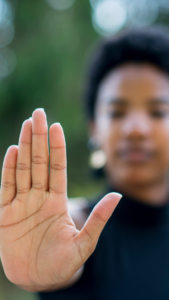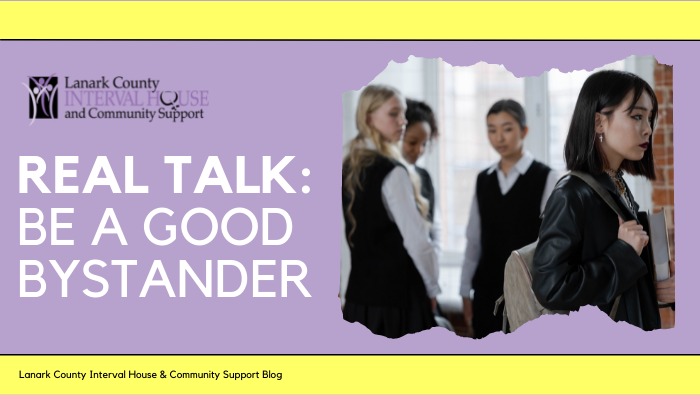Being an Active Bystander
Naming Violence: Being an Active Bystander

Why is it Important to be an Active Bystander?
What’s worse than being harassed in public is being surrounded by bystanders who see it happening but do nothing about it.
When we intervene, not only do we reduce the trauma of harassment for the person who was harmed (yes, harassment can cause trauma!)…we also slowly chip away at the culture of harassment and replace it with one of humanity.
Using the 5 D’s:
The 5Ds are different methods – Distract, Delegate, Document, Delay, and Direct – that you can use to support someone who’s being harassed, emphasize that harassment is not okay, and demonstrate to people in your life that they have the power to make their community safer.
Remember: Always prioritize your own safety and do not get involved if it is too dangerous to do so. No matter which of the 5 D’s you use, always make sure to check on the victim afterwards. Ask if they are okay, offer to sit or walk with them, offer to help them report the incident and validate their experience by letting them know you saw what happened and it wasn’t okay.
Direct
Direct intervention in the situation by inserting yourself. Use this method with caution, because it can be risky – the person harassing may redirect their abuse towards the intervening bystander or may escalate the situation in another way.
The first key to Direct intervention is to assess the situation before you decide to respond, ask yourself if you are you physically safe to do so.Keep it short. As tempting as it may be, avoid engaging in dialogue, debate, or an argument – since this is how situations can escalate.
Confront the harasser in a direct, respectful manner.
Distract
Distract either party. This is a subtle and creative way to intervene and can be simple. It’s aim is simply to derail the incident by interrupting.
Don’t talk about or refer to the harassment that’s happening. Instead, talk about something completely unrelated.
Ask for directions or the time, pretend you know the person being harassed and start talking to them.
Delegate
Delegating means bringing in someone to help you. Look for a Delegate who is ready and willing to help. Often, a great choice is the person right next to you. When you Delegate someone to help you, try to tell them as clearly as possible what you’re witnessing and how you’d like them to help. Speak to someone near you who also notices what’s happening and might be in a better position to intervene. Work together to come up with a plan to intervene.
Document
Take a photo or video of the situation. Assess the situation. Is anyone helping the person being harassed? If not, use another of the 5Ds. Recording someone’s experience of harm without ensuring they’re already receiving help can just create further trauma for them. If someone else is already helping out: assess your own safety, and if you are safe, begin documenting.
Try to say the time out loud in the video and make sure to document the location by including street names or signs and visible landmarks.
Remember, this is just for information. Never livestream or share online – it is not your story to tell. After the incident has ended, let the victim know you have documentation and send it to them or directly to police.
Delay
If the situation is too dangerous, walk away and wait for the situation to pass before interveneing. It’s never too late to act!
Even if we can’t act in the moment, we can still make a difference for someone who’s been harassed by checking in on them after the fact. Many types of harassment happen in passing or very quickly, and it’s not always possible we’ll have a chance to intervene in another way. But we don’t have to just ignore what happened and move on. We can help reduce that person’s trauma by speaking to them after an instance of harassment.
Ask the victim later if they are okay or report it if it’s safe to do so. Let them know you saw what happened and it wasn’t okay
What If I’m the Target?
Be direct, make it clear you are uncomfortable. Cross the street and go to a cafe, put your headphones in.
Remember it’s not your fault and it isn’t your responsibility to have the perfect response. Be resilient! You have the right to be on the streets!
Things to Remember:
Notice and assess safety and decide which of the 5 D’s works for you. What feels the safest?
The is no right or perfect response, but any response is better than nothing!
Always check in on the target as soon as possible to make sure they are okay.
Never make jokes in this situation. It perpetuates the idea that we are being funny.

